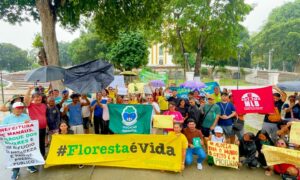By Clara Machado
Would individuals of the same tree species growing in seasonally flooded várzea forest, or unflooded terra firme forest have the same capacity to store carbon as woody biomass? This was a question that PhD student Yennie Bredin with colleagues from Instituto Juruá asked themselves in their publication “Forest type affects the capacity of Amazonian tree species to store carbon as woody biomass”, published in Forest Ecology and Management. Their results show that forest type significantly affects trees’ ability to store carbon.
The trees that grew in the seasonally flooded forests stored less carbon as woody biomass per unit volume than trees of the same species in terra firme. Possibly this difference in carbon accumulation between várzea and terra firme trees resulted from the hydrologic stress that várzea trees are exposed to during flooding. In addition, várzea trees must endure both sedimentation and erosion brought on by the floods. Várzea trees have therefore developed special strategies to tolerate flooding, including specialized woody tissues. Such adaptations may affect the structural formation of biomass in these individuals and especially in pioneer tree species, typically those tree species that occupy the first stages of ecological succession. Information about such adaptations in different tree species to their environment is important for predicting how, for example, climate change or deforestation might affect the capacity of forest trees to store carbon.
Even though most studies estimate carbon stocks uniformly across seasonally flooded and unflooded forest trees, forest habitat may cause differences in tree biomass to be as big as 11%. At the scale of the Amazon basin, this difference would be huge. Therefore, forest habitat is a factor that must be accounted for in Amazonian woody biomass studies to make biomass estimates as realistic as possible. Ultimately, more realistic woody biomass estimates will improve our understanding of how the different Amazonian forests contribute ecosystem services, including atmospheric carbon capture and climate regulation.






